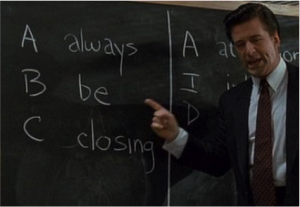How to build authentic customer relationships

Bob Garfield is the co-author of Can’t Buy Me Like, How Authentic Customer Connections Drive Superior Results.
If you had Procter & Gamble’s advertising budget, sales would just go up and up, right?
That’s what Procter & Gamble thought. But after 50 years of growth, sales flatlined for their Secret deodorant brand.
“The Procter & Gamble way of marketing since forever, 100 years plus, is to buy a lot of advertising as efficiently as possible to achieve the greatest amount of reach to promote your positioning and to win customers,” says Bob Garfield, co-author of Can’t Buy Me Like: How Authentic Customer Connections Drive Superior Results.
So why weren’t they able to buy more advertising to win more Secret customers?
“Fragmentation, digital fragmentation, has dramatically decreased the size of the audiences through the traditional channels and spread the audience…into almost an infinite number of tiny little fractions,” says Bob.
Procter & Gamble did break through the plateau, but not by buying advertising. Instead, they connected with customers.
The results? “Secret sales spiked like crazy,” says Bob. “And the sales are still growing across all categories.”
In his Mixergy course, Bob shows you how grow your business like Procter & Gamble did, by connecting to customers. Here are three highlights from the course.
Stop Groveling for a “Like”
 Bribing people to “like” your Facebook page and begging everyone to follow you on Twitter might seem like a good way to quickly grow your customer base, but Bob says it’s a big mistake.
Bribing people to “like” your Facebook page and begging everyone to follow you on Twitter might seem like a good way to quickly grow your customer base, but Bob says it’s a big mistake.
“You go to a restaurant, and the waiter is constantly coming back and fawning all over you…and it’s meant to flatter you, but it really just makes you feel kind of squeamish,” he says. “Nobody likes that feeling because it’s inauthentic. You can tell that someone is just kind of sucking up to you.”
And while you might get a few more fans, “it doesn’t lead to lasting, sustainable relationships,” says Bob. “People write you off as kind of a loser.”
So what should you do instead?
Champion your prospects’ issues
Instead of grovelling to your prospects, champion their issues to create a lasting sustainable relationship.
That’s exactly what Procter & Gamble did for Secret. P&G’s ad agency had come up with “fearlessness in women” for Secret’s positioning, so that “even if you’re wearing silk, you don’t have to worry about some ugly sweat stain ruining your life.”
Instead of begging women to associate fearlessness with Secret, P&G decided to champion female fearlessness instead. “The Olympics were coming, and they were aware of a woman named Lindsey Van, the greatest female ski jumper in the world,” says Bob. But Lindsey wasn’t an Olympic athlete because there was no Olympic ski jumping event for women.
So P&G created a Facebook page and a video to petition to make women’s ski jumping an Olympic event. That resonated strongly with their target of “fearlessness in women” and led to the large increase in Secret’s sales. And happily, the International Olympic Committee declared that women’s ski jumping would be in the 2014 winter games.
Don’t Always Be Closing
 If you view social media as another place to advertise, you’re going to turn off prospects.
If you view social media as another place to advertise, you’re going to turn off prospects.
“People don’t go to social venues to be sold to,” says Bob. “It’s like going to the neighborhood picnic and having the insurance agent down the block handing out business cards. It’s like, ‘Get out of here. Go away.’”
Sure, when you tweet coupons you might get a momentary spike in traffic, but you’re also “losing any kind of personal relationship along the way,” says Bob. “It just becomes a coupon machine, it’s not a sustainable model.”
Use social media to engage, not sell
The primary purpose for social media is to share, and that’s how you should use it, too.
“Go into social media just to meet people and to share ideas and interests and fun stuff and maybe a movement and maybe something very serious,” says Bob.
For instance, when a Krispy Kreme fan snapped a photo of a Krispy Kreme truck next to an Oscar Meyer Weiner car, he tweeted, “Oscar Mayer Weinermobile and Krispy Kreme Cruiser meet by chance.” So Krispy Kreme retweeted it, adding: “That was a sweet moment.”
“People are in social spaces for social contact, they’re not there looking for deals,” says Bob.
Forget About Going Viral
 If you’re dreaming up a viral video to get millions of hits and put your company on the map, stop wasting your time.
If you’re dreaming up a viral video to get millions of hits and put your company on the map, stop wasting your time.
Most videos “never go viral, even with very significant ad budgets to prime the pump,” says Bob. “[They’re] a phenomena, and by their nature they are impossible to predict, they are impossible to engineer. They just happen. And very, very seldom, by the way.”
So what should you do instead?
Provide valuable content
Just create some great, ad-free content.
“You don’t have to do something outrageous and funny and imagine it’s somehow going to [get] 30 million views,” he says. Instead, “there are many things you can do on the web in terms of content,” says Bob, and “you will be cultivating relationships with people who you would like to have in your fold.”
For instance, Betty Crocker personnel create YouTube videos that show parents how to bake birthday cakes for their kids. “[Parents] don’t know how to make a dinosaur cake or a princess cake or a Cinderella cake,” says Bob. “So these are just tutorials, and they are not ads, and millions and millions and millions of people have streamed and downloaded these tutorials.”
Written by April Dykman. Production notes by Alex Champagne.
